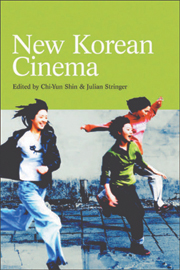Book contents
- Frontmatter
- Contents
- Notes on the Contributors
- List of Illustrations
- Introduction
- Part I Forging a New Cinema
- Part II Generic Transformations
- 6 Putting Korean Cinema in its Place: Genre Classifications and the Contexts of Reception
- 7 Horror as Critique in Tell Me Something and Sympathy for Mr.Vengeance
- 8 Two of a Kind: Gender and Friendship in Friend and Take Care of My Cat
- 9 ‘Just Because’: Comedy, Melodrama and Youth Violence in Attack the Gas Station
- 10 All at Sea? National History and Historiology in Soul's Protest and Phantom, the Submarine
- Part III Social Change and Civil Society
- Glossary of Key Terms
- Bibliography of Works on Korean Cinema
- Websites
- Index
10 - All at Sea? National History and Historiology in Soul's Protest and Phantom, the Submarine
from Part II - Generic Transformations
Published online by Cambridge University Press: 05 August 2013
- Frontmatter
- Contents
- Notes on the Contributors
- List of Illustrations
- Introduction
- Part I Forging a New Cinema
- Part II Generic Transformations
- 6 Putting Korean Cinema in its Place: Genre Classifications and the Contexts of Reception
- 7 Horror as Critique in Tell Me Something and Sympathy for Mr.Vengeance
- 8 Two of a Kind: Gender and Friendship in Friend and Take Care of My Cat
- 9 ‘Just Because’: Comedy, Melodrama and Youth Violence in Attack the Gas Station
- 10 All at Sea? National History and Historiology in Soul's Protest and Phantom, the Submarine
- Part III Social Change and Civil Society
- Glossary of Key Terms
- Bibliography of Works on Korean Cinema
- Websites
- Index
Summary
Introduction
The border between North and South Korea is notoriously impermeable. As Chen Kuan-Hsing (2005) argues in a recent article, the Cold War is far from over in East Asia. He begins his disturbing analysis of the numerous ways it continues to structure developments in Taiwan with a moving account of the rare family reunions that filled Korean television screens in August 2000. This chapter examines some ways in which the ongoing Cold War on the Korean peninsula is shaping North and South Korean cultural developments and differences and, in particular, images of nation and national identity. As well as blocking communications between family members, the Cold War has barred cultural exchange between the North and South for almost fifty years. Therefore, the most fundamental difference between Taiwan and Korea is that, while different Chinese and other ethnic groups inhabit the same space in Taiwan, Koreans have been rigorously separated and their cultures have developed with little contact on the popular level.
At about the same time that the ‘sunshine policy’ pursued by former President Kim Dae Jung from the South enabled family reunions, however, it also opened the door for cultural and sporting exchanges. On 24 August 2001, the North Korean film Soul's Protest (Sarainnǔn ryǒnghondǔl, 2000), directed by Kim Ch'un-song, was screened in Seoul. It presents the North Korean perspective on an historical tragedy.
- Type
- Chapter
- Information
- New Korean Cinema , pp. 144 - 156Publisher: Edinburgh University PressPrint publication year: 2005



